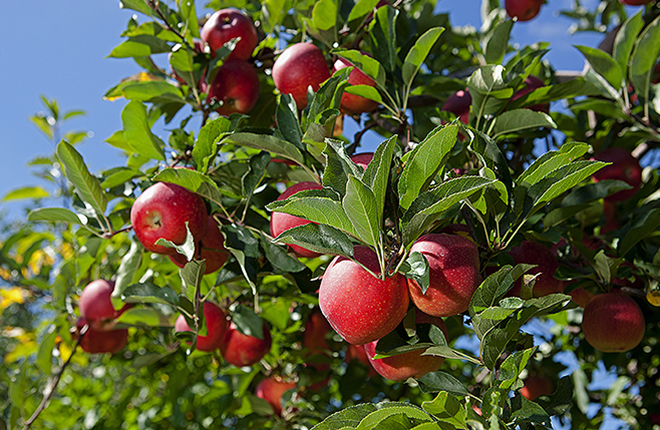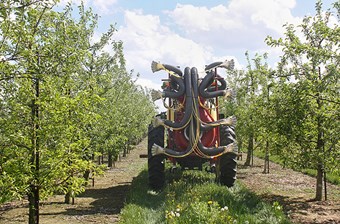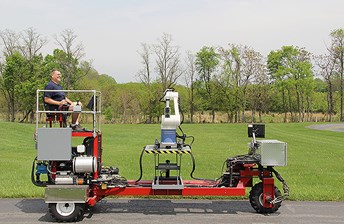Orchard Management Technology
After planting an orchard, a grower must wait a couple of years before the trees bear fruit. Whether the trees are young and growing or mature and productive, orchard managers must monitor them for pest, parasite, and weather damage. Agricultural Research Service (ARS) scientists in several locations are at the forefront of innovative new technologies in orchard management to help growers mitigate losses and achieve optimal fruit yields.
Precision Sprayer
When applying chemicals to crops, where the chemical is delivered is sometimes more important than how much is delivered.
|
|
Led by Agricultural Research Service (ARS) agricultural engineer Heping Zhu, a team—which included ARS agricultural engineer Richard Derksen, plant pathologist Charles Krause, entomologists Michael Reding and Christopher Ranger, and colleagues at the Ohio State University, Oregon State University, and University of Tennessee—successfully developed and tested an innovative laser-guided sprayer to help nursery, orchard, and grape growers apply precise amounts of chemicals.
The system uses high-speed laser scanning technology to image the tree structures, and then an air-assisted variable-rate spraying system controls the spray outputs to match targeted tree structures. The 2-ton sprayer can treat one to six rows of trees at a time.
“Conventional spray application technology requires excessive amounts of pesticide to achieve effective pest control in floral, nursery, orchard, and other specialty crop productions,” says Zhu. “Our automated variable-rate air-assisted precision sprayer overcomes this challenge. Our system characterizes the presence, size, shape, and foliage density of target trees and applies the optimum amount of pesticide in real time.”
Tests in an apple orchard showed that the new sprayer reduced spray loss beyond tree canopies between 40 and 87 percent and reduced spray loss on the ground between 68 and 93 percent.
“Currently, we are expanding this research with additional colleagues at Clemson University, Texas A&M University, and the University of California. The expansion includes development of a universal laser-guided variable-rate spray control system that can be a retrofit on conventional sprayers commonly used in orchards, nurseries, and vineyards,” says Zhu. “In this way, growers can upgrade their existing sprayers to laser-guided precision sprayers by themselves instead of buying new sprayers. Manufacturers can convert their sprayers with the new spray control system without changing their sprayer design. This new precision spraying system will significantly advance the technology for efficient variable-rate pesticide applications, and it offers an environmentally responsible approach to controlling insects and diseases.”
Zhu and his colleagues have received two USDA National Institute of Food and Agriculture grants to develop this technology to control insects and diseases for specialty crops. The technology and performance evaluations were described in several papers in the journal Transactions of the ASABE.
Robotic System for Tree Shape Estimation (RoTSE)
|
|
Fruit trees must be pruned during their winter dormant season for optimal fruit quality and productivity. “If trees are not pruned, fruit quality and productivity will drop,” says ARS agricultural engineer Amy Tabb in Kearneysville, West Virginia. “But it is hard to get people to do this important task, because they have to operate handheld loppers in the winter on ladders all day long.”
Tabb and her colleagues at the ARS Innovative Fruit Production, Improvement, and Protection Laboratory, and Henry Medeiros at Marquette University in Milwaukee, Wisconsin, are looking at ways to make pruning more efficient. They are working on a robotic vision system called the “Robotic System for Tree Shape Estimation” (RoTSE) to determine tree shape in field settings. Tree shape includes the structure, diameter, length, and angles of the branches. “Determining tree shape is important so that pruning can be done efficiently,” says Tabb.
Determining tree traits with a computer vision system is a series of steps. The first step is obtaining the image, which is not just a pretty picture. An articulating robotic arm with a camera attached is mounted in the bed of a small truck. Depending on the complexity of the tree, the camera takes an average of 100 images of it. Combining all of the images, using algorithms designed by Tabb, reveals the tree’s limb structures, sizes, and positions.
Tabb and her team tested the system on apple trees. “Compared to human measurements, RoTSE estimated branch diameter, branch length, and branch angle with small error margins. The average run time was 8:47 minutes,” says Tabb. “We will use this information to develop automated pruning systems.”
Precision Sorter
Harvesting and sorting are other labor-intensive orchard tasks that are getting some attention from ARS scientists. Harvesting accounts for around 15 percent of total production costs, and postharvest storage and packing can account for one third or more of those costs. Because of this, increasing efficiency is of great interest to apple growers.
 This ARS-developed system automatically sorts and grades harvested apples. (Renfu Lu, D3903-1) |
Conventionally, all harvested apples, regardless of their quality grades, are placed in the same bins and then hauled to sheds for storage. “During harvest, pickers do not have time to inspect each fruit. Doing so would greatly reduce their harvest speed, which is not cost effective,” says agricultural engineer Renfu Lu, in East Lansing, Michigan. “But the practice of mixing good fruit with inferior or defective fruit makes the entire lot more susceptible to diseases or pests during postharvest storage.”
Lu’s team has come up with a solution.
In recent years, many orchards have been reconfigured into structured and compacted rows of trees, creating better conditions for orchard mechanization and automation. So in 2016, the team, in collaboration with a commercial horticultural equipment manufacturer in Michigan, designed and constructed the first self-propelled apple-harvest and in-field-sorting prototype machine. “The new machine utilizes low-cost sensors, controls, and a computer, and it can accommodate at least six people picking the apples. While the prototype still requires a worker to steer the machine in the orchard, auto steering will be considered in the future,” says Lu.
The machine transports harvested fruit from three pairs of harvest conveyors to the main conveyor and then to a vision inspection chamber. The machine vision system performs several functions: It aligns the apples in single file, separates them equally, rotates them, takes multiple pictures of each fruit and assigns a quality grade to it, and then sends the graded fruit to a specific bin.
Growers could achieve significant cost savings with such a system. “For example, in a well-managed, high-density, structured orchard, about 10 percent of the fruit is low quality and not suitable for the fresh market. If the machine is used for one full harvest season, the orchard owner could have gross savings of $34,000 in postharvest storage and packing by removing the rotted or damaged fruit at harvest,” says Lu.
The team continued to improve the system’s fruit-handling mechanisms and conveyor designs. “For the 2017 harvest season, we tested the improved machine in a commercial orchard to evaluate its performance. The improvements resulted in minimal bruising damage and a significant improvement in harvest efficiency.”
We held a field demonstration of the machine and received input from growers, extension specialists, and others. Our ultimate goal is to establish a partnership with a commercial horticultural equipment manufacturer to transfer the developed technology to the apple industry,” says Lu.
All of these innovative technologies may help orchard managers be more productive and financially prosperous.—By Sharon Durham, ARS Office of Communications.
Key Facts
- ARS developed tree-structure imaging methods that improve pruning.
- ARS developed a variable-rate pesticide sprayer for precise application in orchards.
- ARS developed a machine to assist with apple harvesting, sorting, and grading.
Full Story









